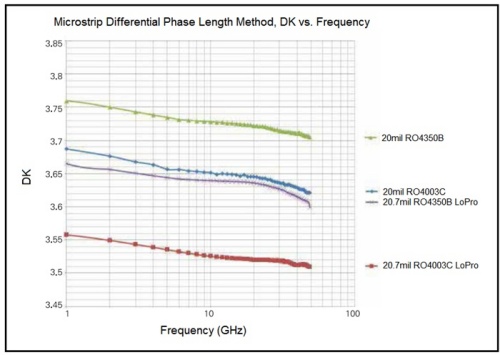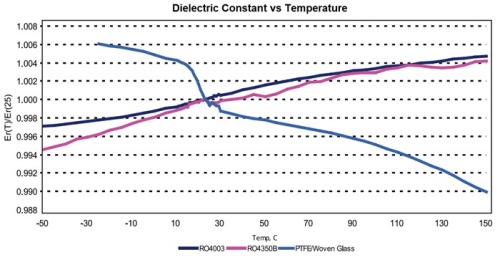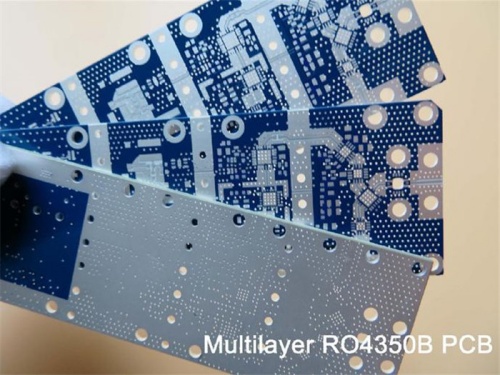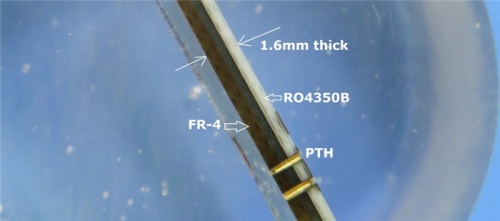| |
|
|
|
|
|
|
|
|
Rogers RO4350B High-Frequency PCB: Coating Thicknesses 10mil, 20mil, 30mil, 60mil with Immersion Gold |
|
|
RO4350B, a laminate from Rogers Corporation, is reinforced with woven glass cloth and filled with hydrocarbon resin ceramic. It has electrical properties highly similar to PTFE/fabric glass cloth material and its processability is comparable to epoxy resin/glass cloth material. |
|
|
|
|
|
The Reason for using RO4350B Laminates |
|
|
1. Outstanding High-Frequency Performance
RO4350B materials are hydrocarbon ceramic filled laminates, distinct from PTFE. They are meticulously engineered to deliver remarkable high-frequency performance, catering to the demanding requirements of modern high-frequency applications.
2. Low Dielectric Loss
The low dielectric loss of RO4350B translates into excellent electrical performance, enabling its use in applications that operate at high frequencies. This characteristic ensures efficient signal transmission and minimal energy dissipation, which is crucial for sensitive electronic systems.
3. Stable Electrical Properties across Frequencies
RO4350B material embodies the essential properties of RF microwave circuits, matching networks, and controlled impedance transmission lines. Its dielectric constant remains steady over a wide frequency spectrum, as demonstrated by the Chart DK vs. frequency. This stability provides reliable performance and predictable behavior in diverse electronic designs.
|
|
|
 |
|
4. Low TCDK
The temperature coefficient of dielectric constant of RO4350B is one of the lowest among all circuit board materials. As can be seen in the Chart DK vs. Temperature, this characteristic enables RO4350B to display excellent dimensional stability. This property is essential for the construction of mixed dielectric multi-layer PCBs and for ensuring reliable plated through holes. |
|
|
 |
|
5. Cost
RO4350B laminates can be manufactured using standard FR-4 processes, eliminating the need for specialized via preparation techniques. They can also be processed with automated handling systems and scrubbing equipment typically used for copper surface preparation. These characteristics make RO4350B suitable for volume manufacturing, allowing for competitive pricing. |
|
|
Our PCB Capability(RO4350B) |
|
|
Our PCB Capability(RO4350B) Double sided circuit boards on RO4350B are available in a variety of thicknesses, such as 10mil, 20mil, 30mil and 60mil. It's used in a variety of typical and non-traditional microwave / radio frequency applications, such as base station antennas, attenuator, power amplifiers, RFID, radar and sensors etc.
|
|
|
Our PCB Capability (RO4350B) |
PCB Material: |
Glass reinforced hydrocarbon ceramic laminates |
Designator: |
Rogers RO4350B |
Dielectric constant: |
3.48 ±0.05 (process) |
|
3.65 (design) |
Layer count: |
Single Layer, Double Layer, Multi-layer, Hybrid Designs |
Copper weight: |
1oz (35µm), 2oz (70µm) |
Laminate thickness: |
4mil (0.102mm), 6.6mil (0.168mm), 10mil (0.254mm), 20mil (0.508mm), 30mil (0.762mm), 60mil (1.524mm) |
PCB size: |
≤400mm X 500mm |
Solder mask: |
Green, Black, Blue, Yellow, Red etc. |
Surface finish: |
Bare copper, HASL, ENIG, Immersion Silver, Immersion tin, OSP, ENEPIG, Pure gold etc. |
|
|
|
Multilayer PCB |
|
|
 |
|
|
The multilayer PCB is constructed using a core of RO4350B, such as a 4-layer board with a 6.6 mil core or a 20 mil core, as well as a 4-layer board utilizing two 10 mil cores. This differs from multilayer PCBs made with FR-4, as the core thickness is fixed. This consistency is crucial for maintaining the electrical length of RF lines on the circuit board.
|
|
|
Hybrid PCB |
|
|
To reduce production costs while minimizing signal loss in high-frequency environments, FR-4 glass fiber material is combined with RO4350B in multilayer circuit boards. The high-frequency material is utilized in the signal layers, while FR-4 glass fiber is employed in the other layers.
|
|
|
 |
|
|
The standard color of RO4350B PCBs is white. We specialize in offering prototype, small batch, and mass production services. If you have any specific requirements for this type of PCB, please don't hesitate to reach out to us. Thank you for your attention. |
|
|
Appendix: RO4350B Typical Value |
|
|
RO4350B Typical Value |
Property |
RO4350B |
Direction |
Units |
Condition |
Test Method |
Dielectric Constant,εProcess |
3.48±0.05 |
Z |
|
10 GHz/23℃ |
IPC-TM-650 2.5.5.5 Clamped Stripline |
Dielectric Constant,εDesign |
3.66 |
Z |
|
8 to 40 GHz |
Differential Phase Length Method |
Dissipation Factortan,δ |
0.0037
0.0031 |
Z |
|
10 GHz/23℃
2.5 GHz/23℃ |
IPC-TM-650 2.5.5.5 |
Thermal Coefficient of ε |
+50 |
Z |
ppm/℃ |
-50℃to 150℃ |
IPC-TM-650 2.5.5.5 |
Volume Resistivity |
1.2 x 1010 |
|
MΩ.cm |
COND A |
IPC-TM-650 2.5.17.1 |
Surface Resistivity |
5.7 x109 |
|
MΩ |
COND A |
IPC-TM-650 2.5.17.1 |
Electrical Strength |
31.2(780) |
Z |
Kv/mm(v/mil) |
0.51mm(0.020") |
IPC-TM-650 2.5.6.2 |
Tensile Modulus |
16,767(2,432)
14,153(2,053) |
X
Y |
MPa(ksi) |
RT |
ASTM D 638 |
Tensile Strength |
203(29.5)
130(18.9) |
X
Y |
MPa(ksi) |
RT |
ASTM D 638 |
Flexural Strength |
255
(37) |
|
MPa
(kpsi) |
|
IPC-TM-650 2.4.4 |
Dimensional Stability |
<0.5 |
X,Y |
mm/m
(mil/inch) |
after etch+E2/150℃ |
IPC-TM-650 2.4.39A |
Coefficient of Thermal Expansion |
10
12
32 |
X
Y
Z |
ppm/℃ |
-55℃to288℃ |
IPC-TM-650 2.4.41 |
Tg |
>280 |
|
℃ TMA |
A |
IPC-TM-650 2.4.24.3 |
Td |
390 |
|
℃ TGA |
|
ASTM D 3850 |
Thermal Conductivity |
0.69 |
|
W/M/oK |
80℃ |
ASTM C518 |
Moisture Absorption |
0.06 |
|
% |
48hrs immersion 0.060"
sample Temperature 50℃ |
ASTM D 570 |
Density |
1.86 |
|
gm/cm3 |
23℃ |
ASTM D 792 |
Copper Peel Stength |
0.88
(5.0) |
|
N/mm
(pli) |
after solder float 1 oz.
EDC Foil |
IPC-TM-650 2.4.8 |
Flammability |
(3)V-0 |
|
|
|
UL 94 |
Lead-free Process Compatible |
Yes |
|
|
|
|
|
|
|
|
|
|
Hot Tags:
Rogers RO4350B High-Frequency PCB |
Hydrocarbon Ceramic Filled RO4350B Laminates |
Rogers RO4350B Price |
Low Dielectric Loss RO4350B |
Rogers RO4350B Thickness |
|
|
|